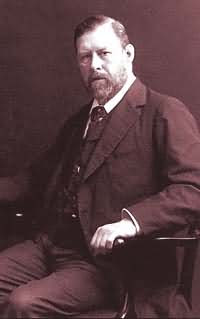The Google Doodle today is a nice tribute to Dubliner Bram
Stoker and his famous Dracula. Stoker was born on November 8th, 1847. He grew
up in Marino a suburb of Dublin. He could not stand on his feet till he was
seven but later went on to excel in the sports field. Stoker turned to fiction
much later in life, his first book published in 1879 was a legal administration
handbook. November 8, 2012 is the 165th birth anniversary of Bram Stoker
(Abraham Stoker) and the Google doodle is inspired by the Irish author's most
famous work – 'Dracula'. The lettering of the word Google on the Bram Stoker
doodle is inspired by the cover of the first edition of 'Dracula' published in
1897.
 |
| Abraham Stoker |
In tune with the plot of the novel, the doodle has an eerie
feel about it. A cloaked Count Dracula menacingly bares his fangs as a crescent
moon appears behind the castle on the Carpathian Mountains. One of Dracula's
favoured shapeshift forms, a bat, flies in the night sky. Other Bram Stoker
characters also appear on the black and white doodle with only the Google
letters appearing in blood red.
 |
| Mount Jerome Cemetery, Dublin |
Not many realise that Abraham Stoker, the creator of Dracula
was a Dubliner and my townsman. A theatre manager in London he loosely modelled
his most famous character on Vlad III, Prince of Wallachia (1431–1476). Vlad was
a member of the House of Drăculești, a branch of the House of Basarab, also
known by his patronymic name: Dracula. Impalement was the Ottoman’s preferred
method of killing when they attacked mainland Europe – a form of psychological warfare
to terrify the Infidels. A Romanian (and Bulgarian) hero for resisting the
Ottomans Vlad was a Transylvanian Saxon who turned the Ottoman’s terror tactics
against them.
Impalement was Vlad's
preferred method of torture and execution. Several woodcuts from German
pamphlets of the late 15th and early 16th centuries show Vlad feasting in a
forest of stakes and their grisly burdens outside Brașov, while a nearby
executioner cuts apart other victims. After being orphaned, betrayed, forced into exile and pursued by his enemies, he retook control of Wallachia in 1456. He dealt harshly with his enemies, especially those who had betrayed his family in the past, or had profited from the misfortunes of Wallachia.
Though a variety of methods was employed, he has been most associated with his use of impalement. The liberal use of capital punishment was eventually extended to Saxon settlers, members of a rival clan, and criminals in his domain, whether they were members of the boyar nobility or peasants, and eventually to any among his subjects that displeased him. Following the multiple campaigns against the invading Ottoman Turks, Vlad would never show mercy to his prisoners of war. The road to the capital of Wallachia eventually became inundated in a "forest" of 20,000 impaled and decaying corpses, and it is reported that an invading army of Turks turned back after encountering thousands of impaled corpses along the Danube River. While Vlad was an impaler that was anal with the victim allowed to slide down the pole at their leisure.
 |
| This could take some time |
Though a variety of methods was employed, he has been most associated with his use of impalement. The liberal use of capital punishment was eventually extended to Saxon settlers, members of a rival clan, and criminals in his domain, whether they were members of the boyar nobility or peasants, and eventually to any among his subjects that displeased him. Following the multiple campaigns against the invading Ottoman Turks, Vlad would never show mercy to his prisoners of war. The road to the capital of Wallachia eventually became inundated in a "forest" of 20,000 impaled and decaying corpses, and it is reported that an invading army of Turks turned back after encountering thousands of impaled corpses along the Danube River. While Vlad was an impaler that was anal with the victim allowed to slide down the pole at their leisure.
 |
| Vlad Tepes |
This form of impalement would have offended Victorian
sensibilities so Stoker got the idea of the stake through the heart from Mount
Jerome Cemetery in Dublin where suicides were buried on unconsecrated grounds
with a stake through their heart so having turned their backs on God (sic) the
Devil could not claim their soul.
There is another Dublin connection to classic gothic horror
fiction with a strong Faustian theme. The birthplace of Bram Stoker, author of
Dracula, is 15 Marino Crescent, Dublin, and when he and Oscar Wilde were young
they were both in love with a girl who lived at another house in this short
crescent on the Northside of Dublin. Oscar Wilde used the Crescent and the room
in the garret as a setting of his only published novel “The Picture of Dorian
Gray.” There are passages in this novel, which has a certain autobiographical content,
which ring true today.
 |
| Marino Crescent, Dublin |
“Each class would have preached the importance of those
virtues, for whose exercise there was no necessity in their own lives. The rich
would have spoken on the value of thrift, and the idle grown eloquent over the
dignity of labour.”
See also; Dracula the Dubliner!
 |
| Dracula, Prince of Darkness, on one of his better days |

Champion of the Northside.
ReplyDeleteGreat post! I love the information on Vlad. The more I learn about him, the more fascinated I am. I had no idea his main enemy was the Ottomans!
ReplyDeleteYou do have veri interesting (and, may I say, a bit creepy) fellow townsmen!
ReplyDelete